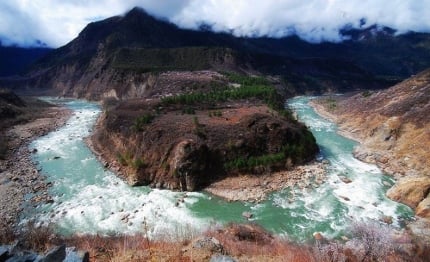This is part of a special report produced by thethirdpole.net on the future of the Brahmaputra river – one of the world’s great transboundary rivers – which starts on the Tibetan Plateau before passing through India and Bangladesh.
Also read:
– Why India and China should leave the Brahmaputra alone
– World’s largest hydropower project planned for the Tibetan Plateau
– Brahmaputra river is a living ecosytem, not just a source of hydropower
The Brahmaputra, or more accurately, the Yarlung Tsangpo Brahmaputra-Jamuna river, begins in the high glaciers of the Tibetan Himalaya. Its most dramatic passages come as it turns to plunge through the world’s deepest gorge: for 400 kilometres, the river twists around the mountains, dropping more than 2,000 metres in altitude and giving up huge energy potential as it goes. Hydropower experts see it as a potential energy Eldorado.
It exits the gorge into the north-eastern corner of India and descends from there into the Assam valley, then to the vast deltaic lowlands of Bangladesh, where it joins with the Ganga. When it reaches the end of its journey in the Bay of Bengal, it has crossed three of the world’s most populous countries – China, India and Bangladesh.
This majestic river carries a volume of water greater than the combined flow of the 20 largest rivers in Europe, a greater volume than any river bar the Amazon and the Congo; it carries vast volumes of silt, the curse of dam builders, but life-giving to farmers and fish, from the high Himalaya to the tropical seas of the Bay of Bengal.
For thousands of years, millions of people have lived along its banks, dependent on its pulse for the rhythms of their lives. It has inspired music and dance, stories and legend, the peoples’ tributes to the unchanging presence that is the foundation of their livelihoods.
But this great river is now under threat, a threat explored further in a special report published by thethirdpole.net. Climate change will alter its flow over the long-term, as glaciers, monsoon patterns and ground water reserves react to rising temperatures and changing patterns of use.
More urgently, and potentially catastrophically, the race to exploit the river’s energy potential, to establish the competitive claims of prior use, to build dams, diversions and barrages to harvest the Brahmaputra’s power, risks destroying not only the river’s unique character, but its wider economic, cultural and ecological value.
It is not only China that is eyeing the energy potential of the Brahmaputra. The lack of a cooperative framework for managing the whole river system has left it vulnerable to short-term, competitive exploitation as rival neighbours race to stake pre-emptive claims.
In India, 168 massive dams are proposed on the upper reaches of the Brahmaputra River and its tributaries in Arunachal Pradesh and Assam, both of them states rich in flora, fauna and cultural diversity. As in China, these plans are being made with little concern for the wider health of the river system or the interests of the millions of people who depend upon it. It is a race in which everyone risks becoming a loser.
This is not an argument against development, but a concern that the wrong kind of development, pursued in competition with neighbouring riparian states, risks destroying vital ecosystems that we only partially understand.
Governments, to date, have not been the Brahmaputra’s friend, prioritising narrow, short-term developments ahead of the long-term health of the river, and the economic and other security of their peoples. As the Indian academic and water expert Rohan D’Souza has powerfully argued, a river must be seen as a “collection of pulses, not a quantum of water flows.” The “hydrocracy” – the water bureaucracy – that has dominated official discussions, he argues, is like the blind person who touches an elephant’s tail and thinks he knows the entire animal.
It is high time we looked at the whole elephant, an effort that demands that we widen the circle of discussion beyond the narrow concerns of state-directed water bureaucracies and hydropower interests. Inter-state rivalry is as blinkered and dangerous an approach as is the predominance of narrow engineering interests over the larger concerns of livelihoods and ecological security.

